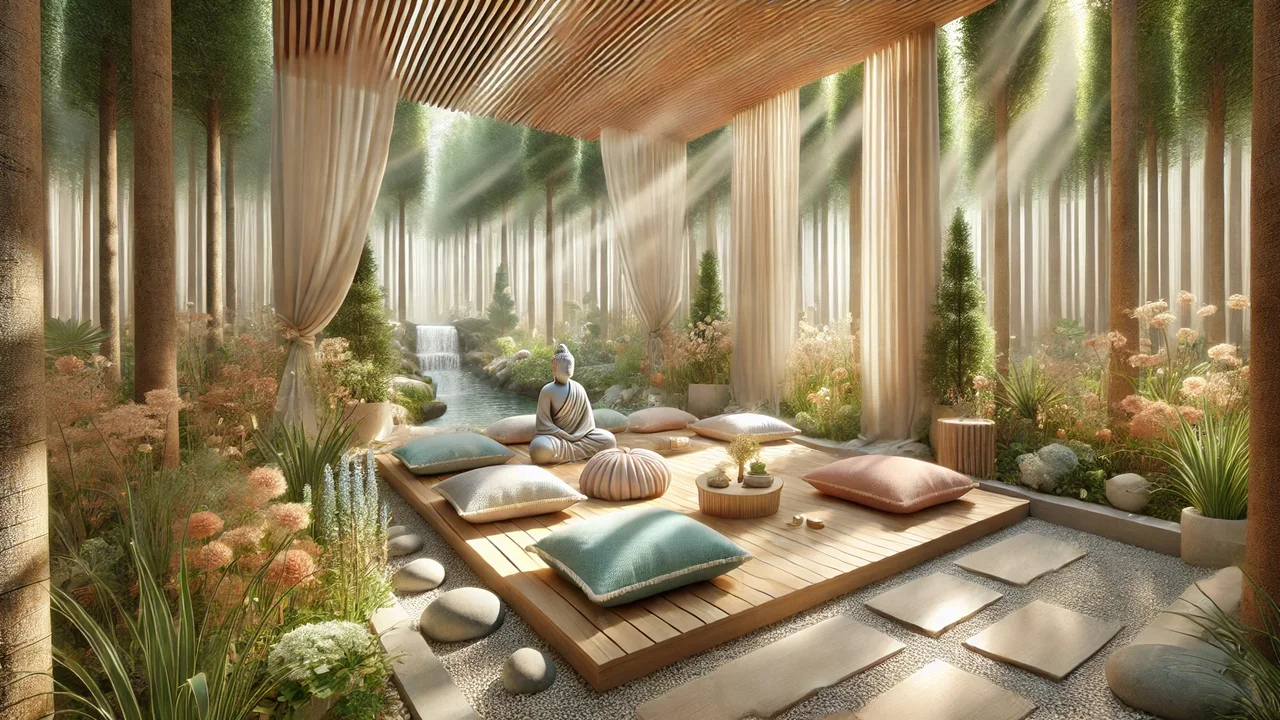In today’s fast-paced world, many people are searching for ways to unwind and find peace. Creating a meditation area in your home is an excellent way to cultivate relaxation and joy. Whether you’re new to meditation or have been practicing for years, designing a space dedicated to mindfulness can enhance your experience and improve your overall well-being. This blog will guide you through the steps to create a serene environment that encourages stress relief.
The Importance of a Dedicated Meditation Space
A special area for meditation helps signal to your mind that it’s time to relax. When you enter this space, your body naturally begins to prepare for mindfulness practice. It’s like having a little sanctuary in your home that is just for you.
Having a defined meditation space also helps maintain consistency in your practice. When it’s inviting and comfortable, you’re more likely to spend time there regularly. It becomes a haven where you can escape the chaos of daily life and focus on your mental health.
Creating a dedicated space doesn’t require much; a quiet corner or a spare room can be transformed with a few thoughtful touches. The key is to make it a place where you feel at ease.
Choosing the Perfect Location
The first step in creating your meditation area is choosing the right location. Look for a space that is quiet and free from distractions. This might be a corner of your bedroom, a spot in the living room, or even a small nook in your garden.
Natural light can enhance your meditation experience, so consider a location near a window. Sunlight can lift your mood and keep your space feeling bright and cheerful. If a window isn’t available, use soft lighting to create a warm and inviting atmosphere.
Privacy is essential, too. Select a spot where you can focus without interruptions. If you live with others, communicate the importance of your meditation time and space, so they understand and respect your need for solitude.
Setting Up Your Meditation Space
Once you’ve chosen a location, it’s time to set up your meditation area. Start with a comfortable seat, like a cushion or a chair, that supports good posture. Comfort is key to staying focused and relaxed during your practice.
Consider adding a soft rug or mat to define your space and provide additional comfort. You might also want to include a blanket or shawl for warmth during colder months. Having these essentials handy can help you adjust to temperature changes and keep your mind on meditation.
Decorate your space with items that bring you joy and serenity. This could include plants, calming artwork, or a small altar with meaningful objects. A touch of nature, like a plant or a Key West painting, can evoke feelings of calmness and connection to the earth.
Incorporating Elements of Nature
Bringing nature into your meditation space can enhance your sense of tranquility and mindfulness. Consider incorporating elements like plants, stones, or water features to create a calming environment.
Plants are excellent additions, as they purify the air and add a touch of greenery. Select low-maintenance options like succulents or ferns, which thrive indoors and don’t require much attention.
A small water feature, like a tabletop fountain, can add a soothing ambiance with its gentle sounds. If a fountain isn’t feasible, use a recording of water sounds to mimic the effect. The sound of flowing water can help drown out background noise and enhance your focus.
Choosing the Right Colors
Color plays a significant role in creating a relaxing meditation space. Soft, muted tones are generally best for evoking a sense of peace and tranquility. Consider using colors like light blue, soft green, or warm beige to create a calming atmosphere.
If you prefer brighter colors, use them as accents rather than the main color scheme. This approach allows you to enjoy their vibrancy without overwhelming your senses.
Experiment with different color combinations to see what resonates with you. Your meditation space should reflect your personal taste while promoting relaxation and joy.
Adding Calming Scents
Aromatherapy is a powerful tool for enhancing meditation and relaxation. Introducing calming scents like lavender, chamomile, or sandalwood can elevate your practice and help reduce stress.
Use essential oils, incense, or scented candles to infuse your space with your chosen aroma. Be mindful of selecting high-quality, natural products to avoid synthetic chemicals that can be overpowering or irritating.
Too many scents can be distracting, so start with one or two and adjust as needed. The goal is to create an inviting space that enhances your meditation experience without overwhelming your senses.
Incorporating Sound for Relaxation
Sound can play a vital role in your meditation practice. Consider incorporating soothing music, nature sounds, or guided meditations to enhance your experience.
Create a playlist of calming music or ambient sounds to play during your practice. Choose tracks with gentle melodies and slow tempos to help you relax and focus.
Alternatively, use a recorded guided meditation to lead you through your practice. This approach can be particularly helpful if you’re new to meditation or seeking variety in your routine.
Personalizing Your Space
Your meditation space should be a reflection of your unique personality and interests. Personalize it with items that inspire relaxation and joy.
Add a personal touch with family photos, inspirational quotes, or meaningful objects. These items can serve as reminders of your values and motivations, helping you stay grounded during meditation.
Feel free to experiment with different layouts and decorations. Your space should evolve with you and your practice, adapting to meet your needs over time.
Maintaining Your Meditation Space
Keeping your meditation area clean and clutter-free is essential for maintaining its calming atmosphere. Regularly dust and tidy up the space to ensure it remains a welcoming sanctuary.
Consider incorporating cleaning rituals into your meditation practice. This could involve lighting a candle, smudging with sage, or playing calming music as you freshen up the area.
Recharge your space by introducing new elements, like fresh flowers or seasonal decorations. These small changes can reinvigorate your practice and keep your space feeling fresh and inviting.
Inviting Others to Share in Your Space
While your meditation space is primarily for personal use, inviting others to join you can deepen your connection to the practice. Sharing your sanctuary with friends or family can foster a sense of community and support.
Host a small meditation gathering or invite a friend to join you for a session. Sharing your space can introduce new perspectives and techniques, enriching your practice.
Be mindful of setting boundaries and respecting each other’s needs. Your space should remain a peaceful sanctuary for everyone involved.
Continuing Your Meditation Journey
Creating a meditation space is just the beginning of your mindfulness journey. Use your sanctuary to explore different meditation techniques and deepen your practice.
Experiment with various styles of meditation, like mindfulness, loving-kindness, or body scan. Each technique offers unique benefits and can enhance your overall experience.
Stay curious and open to learning as you continue your meditation practice. Your space is a tool for growth and exploration, so make the most of it.
Conclusion
Incorporating a dedicated meditation area in your home can significantly enhance your practice and promote relaxation and joy. With careful consideration and personalization, you can create a sanctuary that supports your mental and emotional well-being.
By following these guidelines, you’ll establish a meditation space that resonates with your unique tastes and needs. Remember that your sanctuary is a work in progress, evolving alongside you and your practice.
To further explore meditation techniques and resources, consider joining a local meditation group or seeking guidance from experienced practitioners. Your meditation space is just the beginning of your mindfulness journey, and the possibilities for growth and transformation are endless.

Stephen Norman is a skilled and accomplished writer known for his versatility across numerous niches. He consistently delivers insightful and engaging content in various fields. Stephen’s extensive experience and profound expertise make him a highly sought-after author in the digital writing sphere.











